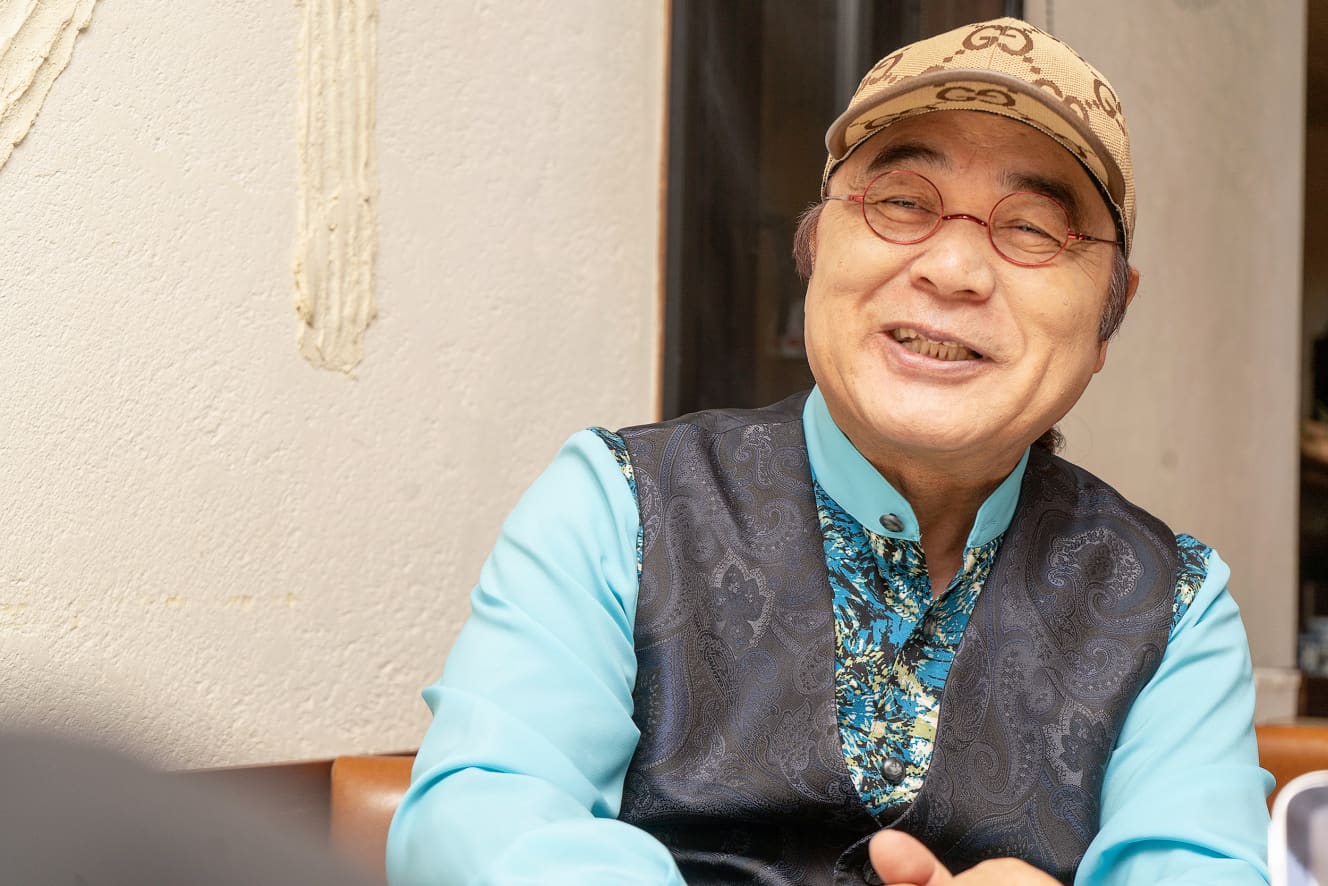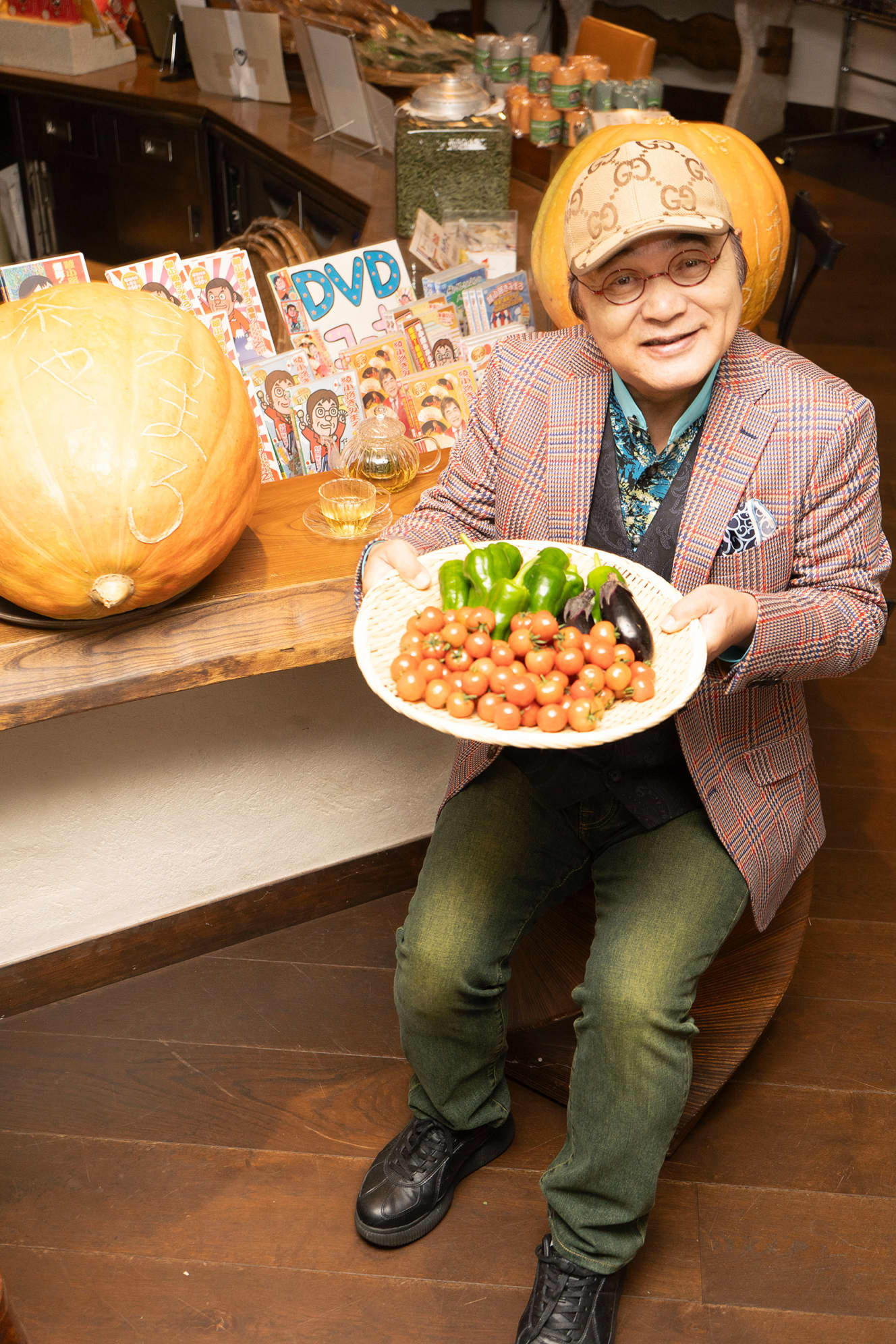Kimimaro Ayanokôji Trades TV Fame for Farming by Lake Kawaguchi
 He takes time out of his busy stage schedule to tend his own farm. He is always on his feet for about an hour on stage. After a performance, dentures and hearing aids from audience members who have laughed too hard sometimes fall out in the audience.
He takes time out of his busy stage schedule to tend his own farm. He is always on his feet for about an hour on stage. After a performance, dentures and hearing aids from audience members who have laughed too hard sometimes fall out in the audience.“60 shows a year! I’m still talking on stage!!”
“Welcome! What did you come to ask today? If it’s about the new LDP president, Ishiba, I know him very well, you know? He doesn’t know me though. Let me say this first.. Alright, here’s my bare face” (removes his hat).
Starting with a light-hearted conversation, the comedian Kimimaro Ayanokôji (73) removes his cap, revealing what is usually “private” under it. With a big smile, he greets the Friday reporter and starts speaking while pouring homemade herbal tea into a cup.
“Recently, TV appearances have been sparse. Once you hit your 70s, it feels like a dismissal from the team. I’ve been in this industry for a long time, full of dreams, hopes, misunderstandings, and illusions. But lately, I’ve been busy on stage. Around 60 performances a year! You know, I have friends in Russia, but no matter how many times I try to call, I can never get through. The phone just goes beep, beep, and then you hear a ‘chime’ sound. …I end up talking for about an hour on just this kind of stuff. Since I don’t have any writers, I come up with my own material and just go with the flow every day.”
In fact, he had changed his style of comedy.
He broke out at the age of 51 in 2002. His first stand-up CD, released at the same time as artists like EXILE and Ayumi Hamasaki, reached a peak position of No. 3 on the Oricon charts and sold a total of 1.85 million copies. Kimimaro Ayanokôji was known for his sharp-tongued comedy based on the “common experiences” of middle-aged and older people, but he had actually been reassessing his comedic style.
“Before, I used to make jokes about people’s appearances or health problems, like ‘Middle-aged people have no teeth, no hair, and no future,’ or ‘If you wear a bodysuit and force it, you’ll look like a ham.’ People would laugh, but they didn’t think it was about themselves. They thought I was talking about their spouse sitting next to them, so I would attack relentlessly with a fast tempo.
But in 2009, when I was featured on NHK’s Close-Up Gendai, the host commented, ‘It’s strange that the audience is laughing even though you’re pointing out their flaws.’ That hit me hard. I hadn’t noticed it myself, but when I thought about it, I realized it wasn’t good. Since I was talking unilaterally, it could have felt like I was abusing the audience. From then on, when I created new material, I began incorporating self-deprecation like, ‘I’m getting older, and I’m becoming like this,’ so that the audience could relate.”
As he grew older and became an elderly person himself, Kimimaro reflected that the senior figures who used to give him advice were no longer around. When he shifted to a self-deprecating style, he felt a sense of relief. There were also other positive changes.
“Since the pandemic settled down, the audience has broadened. The older audience in their 60s hasn’t changed, but the younger crowd in their 30s has joined in. When I first became popular, I thought I would grow old with the elderly fans, and as they disappeared, I would too.
But now, the children who used to listen with their parents or grandparents have grown up and still come to my performances. I can really feel the passage of time. If you stay healthy and keep working hard, you can still reach a lot of people, and that encourages me.”
50 million yen in debt
Currently, Kimimaro Ayanokôji lives in a house on top of a mountain overlooking Mount Fuji near Lake Kawaguchi in Yamanashi Prefecture, where he also runs a farm at the foot of the mountain. The farm, named “Ponpoko Farm,” is being cultivated with seasonal flowers and herbs in a French-style garden. Additionally, a café near the farm sells his homemade herbal teas and “Kimimaro goods,” with a lively display of antiques and driftwood he has collected as a hobby. Ayanokôji shares that his source of comfort now is tending to the farm while gazing at Mount Fuji. Despite this serene life, the villa on the mountain was actually purchased during his difficult years before his big break.
“I’m from Kagoshima, and when I moved to Tokyo at 18, I was captivated by Mount Fuji. My family was in farming, so I always dreamed of living a life where I could farm while enjoying the view of Mount Fuji. I bought the property for 50 million yen at that time! Looking back, I think it was too expensive, so I felt a bit deceived, haha. At that time, I was a 48-year-old, struggling stand-up comedian. I couldn’t get a loan, so my wife helped me with it. I had to succeed no matter what.
I started by distributing tapes of my comedy at highway service areas to bus tour guides, and it became popular through word of mouth. That’s how I was able to break through. At first, I thought I would make just enough to live comfortably, but the success came far beyond my expectations, and I became too busy to go back to the house in Kawaguchi for a while, haha.”
Before his breakthrough, Ayanokôji worked as a host for stars like Shinichi Mori while also performing stand-up comedy.
“After working as a bellboy at a cabaret in Adachi Ward at 19, I started hosting at a cabaret in Shinjuku’s Fūrin Kaikan. Later, I decided to pursue a career as a comedian, wanting to be the one introduced, not just the one introducing others. I admired the legendary host, the late Hiroshi Tamaki, and since I already had a sharp tongue, I would say things like, ‘Even though I have no money, welcome!’ and would get things thrown at me from the audience, like ‘What the heck!’ I’d get beer poured on me, or ashtrays and snacks thrown at me, haha. I also met a young Beat Takeshi at the cabaret before he was famous, and we even drank together. It was a deep experience when I later got to appear with Takeshi on his show, 30 years after my own breakthrough.”
Having lived through much of the Showa era, Ayanokôji, now close to 77, continues to stay active and keeps his antennae up for new material.
“Collecting antiques is a hobby of mine, and I hope to have an exhibition someday. I’ve also started YouTube and am doing it at a manageable pace, hoping to reach more people. Above all, I want to keep creating new material with my antennae always up so I can continue to make people laugh on stage.”
The idol of middle-aged people is still going strong.




 Exclusive photos for the magazine: Kimimaro Ayanokôji’s life in his 70s! “A daily life of growing vegetables and creating new material.”
Exclusive photos for the magazine: Kimimaro Ayanokôji’s life in his 70s! “A daily life of growing vegetables and creating new material.”Interview and text by: Hirotsuru Fujiyama PHOTO: Takayuki Ogawauchi (1st photo)